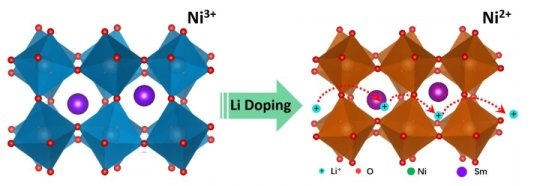[ad_1]
Researchers have shown how to shuttle lithium ions back and forth into the crystal structure of a quantum material, representing a new avenue for research and potential applications in batteries, “smart windows” and brain-inspired computers containing artificial synapses.
The research centers on a material called samarium nickelate, which is a quantum material, meaning its performance taps into quantum mechanical interactions. Samarium nickelate is in a class of quantum materials called strongly correlated electron systems, which have exotic electronic and magnetic properties.
The researchers “doped” the material with lithium ions, meaning the ions were added to the material’s crystal structure.
The addition of lithium ions causes the crystal to expand and increases the material’s conduction of the ions. The researchers also learned that the effect works with other types of ions, particularly sodium ions, pointing to potential applications in energy storage.
Findings are detailed in a paper appearing this week in Proceedings of the National Academy of Sciences.
“The results highlight the potential of quantum materials and emergent physics in the design of ion conductors,” said Shriram Ramanathan, a Purdue University professor of materials engineering who is leading the research. “There is a lot of research now going on to identify solid-state ion conductors for building batteries, for example. We showed that this general family of materials can hold these ions, so we established some general principles for the design of these sorts of solid-state ion conductors. We showed that ions like lithium and sodium can move through this solid material, and this opens up new directions for research.”
Applying a voltage caused the ions to occupy spaces between atoms in the crystal lattice of the material. The effect could represent a more efficient method to store and conduct electricity. Such an effect could lead to new types of batteries and artificial synapses in “neuromorphic,” or brain-inspired, computers. Moreover, the ions remained in place after the current was turned off, a “non-volatile” behavior that might be harnessed for computer memory.
Adding lithium ions to the crystal structure also changes the material’s optical properties, suggesting potential applications as coatings for “smart windows” whose light transmission properties are altered when voltage is applied.
The research paper’s lead authors are Purdue materials engineering postdoctoral research associate Yifei Sun and Michele Kotiuga, a postdoctoral fellow in the Department of Physics and Astronomy at Rutgers University. The work was performed by researchers at several research institutions. A complete listing of co-authors is available in the abstract. To develop the doping process, materials engineers collaborated with Vilas Pol, a Purdue associate professor of chemical engineering and materials engineering, and Purdue graduate student Dawgen Lim.
The research findings demonstrated behavior related to the “Mott transition,” a quantum mechanical effect describing how the addition of electrons can change the conducting behavior of a material.
“As we add more electrons to the system the material becomes less and less conducting, which makes it a very interesting system to study, and this effect can only be explained through quantum mechanics,” Ramanathan said.
Kotiuga’s contribution to the work was to study the electronic properties of lithium-doped samarium nickelate as well as the changes to the crystal structure after doping.
“My calculations show that undoped samarium nickelate is a narrow-gapped semiconductor, meaning that even though it is not metallic, electrons can be excited into a conducting state without too much trouble,” she said. “As lithium is added to samarium nickelate the lithium ion will bind to an oxygen and an electron localizes on a nearby nickel-oxygen octahedron, and when an electron has localized on every nickel-oxygen octahedron the material is converted into an insulator. This is a rather counterintuitive result: the added electrons to the system make the material more insulating.”
The material’s crystal structure was characterized using a synchrotron-radiation light source research facility at Argonne National Laboratory.
The researchers had been working on the paper for about two years and plan to further explore the material’s quantum behavior and potential applications in brain-inspired computing.
The research was funded or otherwise supported by several sources, including the National Science Foundation, U.S. Department of Energy, the Canadian Light Source, U.S. Army Research Office, U.S. Air Force Office of Scientific Research and the U.S. Office of Naval Research.
Story Source:
Materials provided by Purdue University. Original written by Emil Venere. Note: Content may be edited for style and length.
[ad_2]















